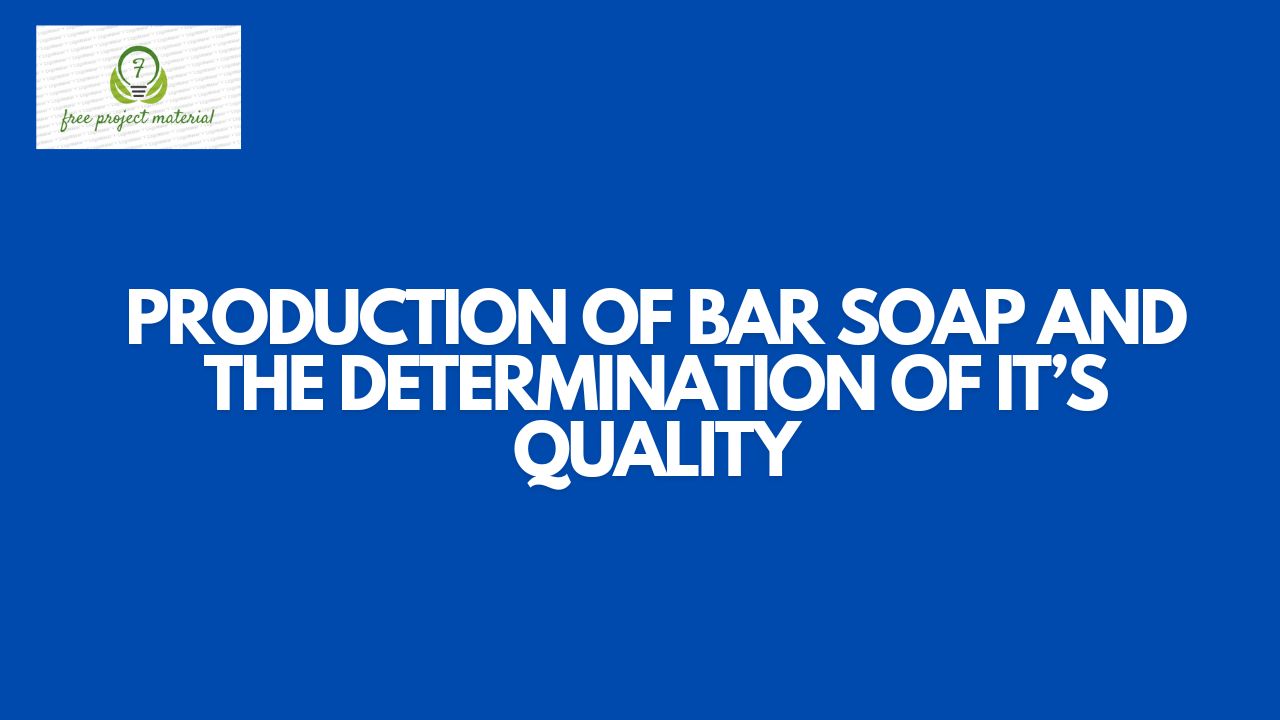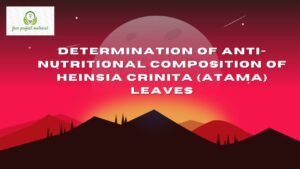ABSTRACT
The bar soap was produced using standard methods and the quality parameters were determined with the use of standard analytical procedures. The result of the study revealed the following: texture of the soap was (hard), foaming stability (stable), pH (10.0), time taken to dissolve (15 min. 25 sec.) and colour (green). While that of the canoe soap was hard, very stable, 9.0, 16min 34 sec., and brown respectively. The chemical characteristic of the soap produced was comparable with that of the canoe soap. These properties showed that the soap was suitable for use in household for laundering and bathing. It is recommended that local producers of soap should endeavour to follow approved specifications while producing their soap.
TABLE OF CONTENT
Title Page – – – – – – – – – i
Certification – – – – – – – – – ii
Dedication – – – – – – – – – iii
Acknowledgement – – – – – – – – iv
Abstract – – – – – – – – – v
Table of Content – – – – – – – – vi
CHAPTER ONE: INTRODUCTION
Background of the Study – – – – – – – 1
Aim and Objectives of the Study – – – – – 4
Scope and Limitation of the Study – – – – – 4
CHAPTER TWO: LITERATURE REVIEW
2.1 History of Soap – – – – – – – 5
2.2 Types of Soaps – – – – – – – 6
2.3 Non-Toilet Soaps – – – – – – – 7
2.4 Toilet Soap – – – – – – – – 8
2.5 Differences Between Soap and Detergent – – – 10
2.6 Raw Materials for Soap Production – – – – 13
2.7 Fatty and Allied Materials – – – – – 13
2.8 Non-Fatty Materials – – – – – – 18
2.9 Soap Manufacturing Processes – – – – – 21
2.10 Cold Process – – – – – – – 21
2.11 Semi-Hot Process – – – – – – – 22
2.12 Hot Process – – – – – – – – 23
2.13 Chemistry of Soap Formation – – – – – 26
2.14 Finishing Processes for Laundry Soaps – – – 27
2.15 Colling and Solidifying – – – – – – 27
2.16 Slabbing, Slicing, Barring and Cutting – – – – 28
2.17 Drying – – – – – – – – – 28
2.18 Stamping and Pressing – – – – – – 29
2.19 Wrapping and Packaging – – – – – – 29
2.20 Soaps Qualities and Quality Control – – – – 29
2.21 Soap Analysis – – – – – – – 31
2.22 Total Fatty Acid – – – – – – – 32
2.23 Free Alkalinity – – – – – – – 32
2.24 Salt – – – – – – – – – 32
2.25 Glycerol – – – – – – – – 32
2.26 Colour – – – – – – – – – 32
CHAPTER THREE: MATERIALS AND METHOD
3.1 Materials and Reagents – – – – – – 33
3.2 Methods – – – – – – – – 34
3.3 Preparation of Lye – – – – – – – 34
3.4 General Soap Making Procedures – – – – 34
3.5 Analysis of Soap Sample – – – – – – 35
CHAPTER FOUR: RESULT AND DISCUSSION
4.1 Result – – – – – – – – – 36
4.2 Discussion – – – – – – – – 37
CHAPTER FIVE: SUMMARY AND CONCLUSION
5.1 Summary – – – – – – – – 39
5.2 Conclusion – – – – – – – – 39
5.3 Recommendations – – – – – – – 40
References
CHAPTER ONE: INTRODUCTION
1.1 Background of the Study
Soaps are sodium or potassium salts of fatty acids. Soap is the oldest product which dates b ack to around 2800BC in Ancient Babylon (Ossa, 2014). Soap was prepared by heating animal fat or oil with wood ashes. Wood ashes contain potassium carbonate and sodium carbonate which make the solution basic. The modern commercial method of making soap involves boiling fats or oils in aqueous sodium hydroxide or potassium hydroxide and adding sodium chloride or potassium chloride or precipitate the soaps respectively. The soap is then dried and pressed into bars. Perfumes can be added for scented soaps, dyes can be added for coloured soaps, sand can be added for scouring soaps, and air can be blown into the soap to make it float (Nangbes et al., 2007).
The features and characteristics of soap product that is to satisfy the needs of a consumer is its quality. However, toilet soaps sold directly to consumer are usually made to manufacturers own formulations and specifications, rather than to any official quality specification, although such specification might perhaps be involved if questions of trade description arise. Thus the need for constant quality surveillance on the commercially available toilet soaps sold in the open markets is important (Prince 2015). Toilet bas are filled soap tablets but often mixed with synthetic detergents to give a rich creamy lather desired of most soap products. This also have the advantage of not leaving scum deposits in the bath or wash basin in hard water and is also cost effective (Butler, 2017).
Toilet soap tablets are premium soap products that have strict specifications of fine texture free from Objectionable odour and have good lathering and cleansing properties (Woollatt, 2018). The fatty acids, stearic, palmitic, myristic, lauric and oleic acid contribute to lathering and washing properties of the soaps (Ogunsuyi and Akinawo, 2012). The chemical characteristics of soap depends on several factors, the strength and purity of alkali, the kind of oil used, completeness of saponification (Ossai, 2014). Poor quality soaps can cause skin discomforts such as acne, eczema, hives, rashes, skin irritation and possibly lead to cancer (Butler, 2017). Although soap is effective in removing grime and is relatively inexpensive, alkaline soaps or those with high content of percentage free alkali can cause skin irritation, dryness and scaling which can predispose the skin to fungal attacks (Ossa, 2014). This is because the excess alkali will saponify the fats and oils, normally found in the skin as a protective coat, to form soluble soap and therefore get washed away, thereby rendering the skin dry, consequently, good toilet soap should contain little or no free alkali. Super fatted products which are mild to use on the skin are premium products. Inidcation of this is also high %UFM, % Rosin RFM and % glycerol. However, products with very high glycerol will tend to be very soft and the economy of usage is placed at a disadvantage (Ossai et al., 2014). Some physicochemical properties include moisture content, total fatty acids (TFM), pH, free alkali, matter soluble in alcohol and percent chloride (Ahmed, 2014).
Soap is an anionic surfactant used in conjunction with water for washing and cleaning. Although the reaction is shown as one step reaction, it is fact two steps. The net effects as that the ester bonds are broken. The glycerol turns back into an alcohol. The fatty acid portion is turned into a salt because of the presence of a basic solution of the NaOH. In the carbonyl group, one oxygen how has a negative charge that attracts the positive sodium ion (Joselany et al., 2011).
1.2 Aim and Objectives of the Study
The aim of this study is to produce bar soap and determine its quality.
The Objectives of this study are:
To assess the quality of bar soap produced
To Enumerate the process of soap production
To make recommendations based on the findings of this study
1.3 Scope and Limitation of the Study
This study deals with the production and bar soap determination of the quality.t his study is delimited due to time and financial constraint.


